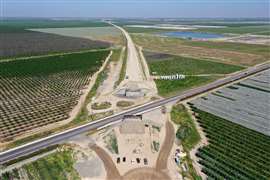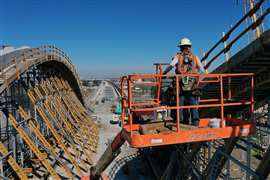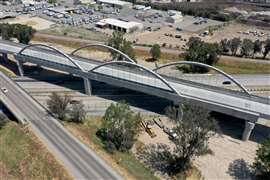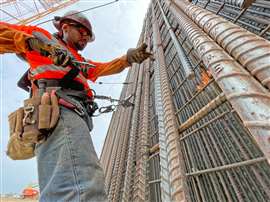The challenges of building California High-Speed Rail
07 November 2023
Garth Fernandez, Central Valley regional director for the California High-Speed Rail Authority, tells International Construction what some of the most-challenging aspects of the multi-billion-dollar megaproject are, where construction stands, and what work is still to come.
 State Route 43 tied arch bridge (Image: California High-Speed Rail Authority)
State Route 43 tied arch bridge (Image: California High-Speed Rail Authority)
California High Speed Rail will be the first fully electrified high speed rail system in the United States when it finally enters service.
The plan, when California voted in favour of a $9 billion bond authorization in 2008 to kickstart construction, was that the completed line would whisk passengers from Los Angeles to San Francisco within two hours and 40 minutes.
Some 15 years later, 119 miles of the line are under construction, spread over five counties in California’s Central Valley. Work is also underway to advance design for the project to run the 171 miles from Merced to Bakersfield. That would cost an estimated $35 billion and launch as early as 2030.
But the prospect of building the full line between the Bay Area and Los Angeles remains further off. And it emerged earlier this year that the cost of building the railway in its entirety could cost between $88 billion and $128 billion.
The challenges
Garth Fernandez, Central Valley regional director for the California High-Speed Rail Authority explains that the megaproject came with several challenges, which he splits into four areas:
- The requirement to follow existing transportation corridors;
- The project not being fully funded;
- The lack of a consistent, reliable funding source;
- The need to execute new agreements with all local agencies, regulatory agencies and utility companies.
Spending on the project so far is in the region of $10 billion, with most of that coming from the State of California. To get it completed in full will require federal funding and the Authority revealed earlier this year that it planned to obtain large new grants from the Bipartisan Infrastructure Law (BIL) to move the project further forward.
 A worker in the basket of a MEWP on the Cedar Viaduct (Image: California High-Speed Rail Authority)
A worker in the basket of a MEWP on the Cedar Viaduct (Image: California High-Speed Rail Authority)
California recently won $202 million in federal funding for grade separation projects and is seeking a further $8 billion in grants over five years. However, at the end of October, it emerged that the Republican-led US House of Representatives planned to vote on legislation that would bar the Biden administration from awarding more funds to the project.
As far as work on the project so far is concerned, there are nearly 30 active construction sites currently, with 40 structures in the Central Valley already built. More sites are due to break ground over the next several months.
Fernandez says, “The most challenging aspect was being in construction ahead of property acquisition. Our project within the 119 miles needed to acquire around 2,300 properties to construct. We are also relocating more than 1,800 utilities ranging from telecommunications, electric, gas, water, and sewer that needed to be done in advance of completing the major infrastructure elements.
“One of the several challenges was that the scope of work not fully defined when project was advertised. Most agreements with local agencies, regulatory agencies, and utility companies were not executed at the time of advertisement thereby creating additional requirements and restrictions from the owners, constrained work windows and added scope as these were finalised. All of this resulted in significant scope modifications, a need for acquiring several more properties resulting in cost and schedule challenges.”
Nonetheless, Fernandez says there had since been “great progress” in executing agreements with the high-speed rail corridor now fully designed to establish scope.
He says the acquisition process is now 97% complete, with a “handful” of acquisitions remaining and several utilities yet to be relocated. “Property acquisition and resolving land rights is a diminishing risk that will remain until all utilities are relocated,” he asserts.
 Cedar Viaduct (Image: California High-Speed Rail Authority)
Cedar Viaduct (Image: California High-Speed Rail Authority)
Fernandez, who has 30 years’ experience in project delivery and has worked on projects both as a designer and construction project manager, adds, “Every project I have worked on was unique and came with its personnel and technical challenges. This project is no different in that regard, as you could look at it as delivering several projects.
“However, working on the high-speed rail mega project has presented unique and complex challenges due to the immense scale, substantial budget, extended timelines, and a high level of complexity on account of the interaction between the various functional elements.
“Collaboration between the several large teams, substantial labour and material needs, robust risk planning and management, and agility are key elements to the success of the program. The margin of error is small, and the cost or schedule impact associated with an error or mistake could be severe, necessitating a heightened focus on execution and the ability to navigate through unforeseen obstacles.”
Nonetheless, Fernandez says the team at the Authority is “highly motivated, confident, determined, and integrated”.
“We have learned from several mistakes and are driving towards our aggressive but attainable goal to have an interim operational segment in the Central Valley in the 2030 to 2033 timeline,” he says.
Innovative techniques
Work underway at the moment involves the heavy civil infrastructure of the project, comprising 115 structures, over 200 wildlife crossings and the placing of over 24 million cubic yards of earth. Construction of a 35-mile intrusion protection barrier is also underway.
To assist in the construction, there is a concrete pre-casting facility at Hanford that produces all of the California Wide Flange girders (adopted by Caltrans as a standard section in 2012), as well as deck panels and piles for construction package 2-3 (see below). The facility is also pre-casting tub girders for various viaducts on site (see video below).
Meanwhile, contractors are using Tier 4 construction equipment to reduce the amount of pollutants released during construction. In the future, the Authority will require future contractors to utilise 100% zero-emission fleets, although it did not indicate when this requirement will be introduced.
Legacy
The Authority recently approved the release of a Request for Qualifications for electrified high-speed trainsets. This trainset procurement process will allow the Authority to procure six trainsets capable of operating at 220 mph, with two prototypes due for trial running in 2028, ahead of four additional trainsets by the end of 2030 to support revenue operations on the 171-mile Merced to Bakersfield section.
Last year, the Authority announced it would be restructuring its track and systems procurement due to high inflation, supply chain challenges and economic climate. It is now in the process of re packaging by selecting procurement methods that provide us more flexibility, innovation, and ability to manage effectively.
Despite the significant challenges involved, Fernandez says, “I am confident that once complete, the California High Speed Rail system will provide an alternative mode of transportation that is sustainable, faster, clean and energy efficient way to get across California.”
And he adds that the project has so far created more than 11,000 jobs, with 70% of those going directly to people from the Central Valley.
“We’ve been able to keep these jobs close to home, some of these workers having to commute only 20 to 30 minutes to the jobs site. While I can’t speak for all of them, I can say personally I’ve heard from several who are glad to work close to home and proud to work on such a historic transportation project,” he concludes.
 A worker on the Conejo Viaduct (Image: California High-Speed Rail Authority)
A worker on the Conejo Viaduct (Image: California High-Speed Rail Authority)
Who is building California High Speed Rail?
In the Central Valley, there are 119 miles of track currently under construction, spread over five counties. Those 119 miles are divided into three design-build construction packages:
- Construction Package 1 comprises 32 miles of line spanning from Avenue 19 in Madera County to American Avenue in Fresno County. This construction package is being built by Tutor-Perini/Zachry/Parsons. The 32 miles includes several grade separations and large viaducts including the completed San Joaquin River Viaduct and Cedar Viaduct, featuring single- or double-span arches respectively. This section traverses through the heart of the city of Fresno and has the Fresno Station within its limits.
- Construction Package 2-3 is 65 miles long and is the largest construction package. It begins at the terminus of Construction Package 1 and stretches to a mile north of the Tulare-Kern County line. Dragados-Flatiron joint venture is the design builder. Multiple grade separations will be built across some of the rural parts of Fresno, Kings and Tulare counties. Construction Package 2-3 is also home to the largest high-speed rail structure, the Hanford Viaduct, which spans more than 6,300 feet (1,920 metres) long and is the location of the Kings/Tulare regional High-Speed Rail Station.
- Construction Package 4 is 22 miles long from a mile north of the Tulare-Kern County line to Poplar Avenue, just north of the city of Shafter in Kern County. Design build contractor California Rail Builders is a joint venture of Ferrovial-Agroman West, LLC and Griffith Company. Construction Package 4 will be the first completed construction package in the Central Valley, anticipated to be done by the end of 2023.
STAY CONNECTED



Receive the information you need when you need it through our world-leading magazines, newsletters and daily briefings.
CONNECT WITH THE TEAM








